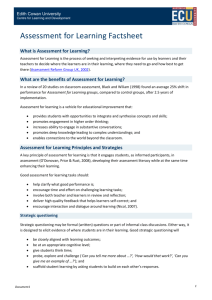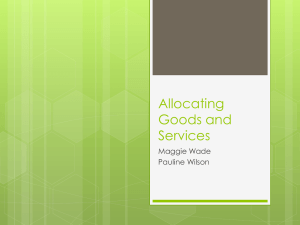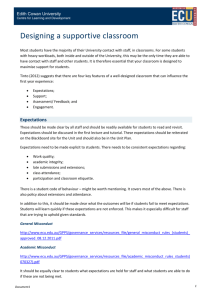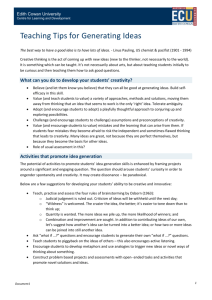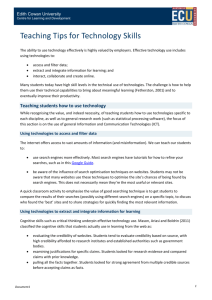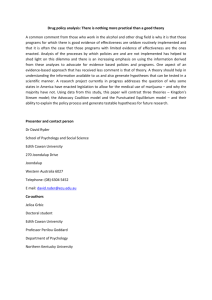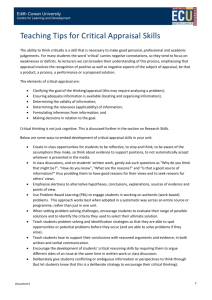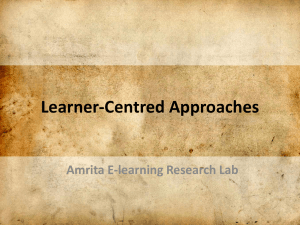Design Activities for active learning
advertisement
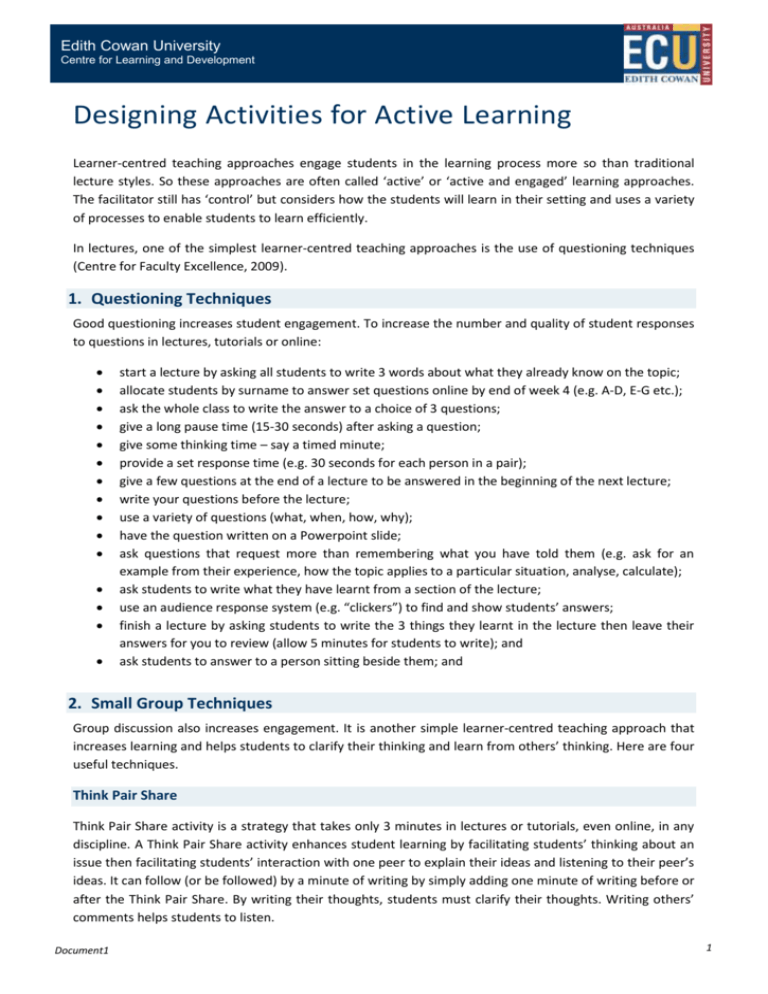
Edith Cowan University Centre for Learning and Development Designing Activities for Active Learning Learner-centred teaching approaches engage students in the learning process more so than traditional lecture styles. So these approaches are often called ‘active’ or ‘active and engaged’ learning approaches. The facilitator still has ‘control’ but considers how the students will learn in their setting and uses a variety of processes to enable students to learn efficiently. In lectures, one of the simplest learner-centred teaching approaches is the use of questioning techniques (Centre for Faculty Excellence, 2009). 1. Questioning Techniques Good questioning increases student engagement. To increase the number and quality of student responses to questions in lectures, tutorials or online: start a lecture by asking all students to write 3 words about what they already know on the topic; allocate students by surname to answer set questions online by end of week 4 (e.g. A-D, E-G etc.); ask the whole class to write the answer to a choice of 3 questions; give a long pause time (15-30 seconds) after asking a question; give some thinking time – say a timed minute; provide a set response time (e.g. 30 seconds for each person in a pair); give a few questions at the end of a lecture to be answered in the beginning of the next lecture; write your questions before the lecture; use a variety of questions (what, when, how, why); have the question written on a Powerpoint slide; ask questions that request more than remembering what you have told them (e.g. ask for an example from their experience, how the topic applies to a particular situation, analyse, calculate); ask students to write what they have learnt from a section of the lecture; use an audience response system (e.g. “clickers”) to find and show students’ answers; finish a lecture by asking students to write the 3 things they learnt in the lecture then leave their answers for you to review (allow 5 minutes for students to write); and ask students to answer to a person sitting beside them; and 2. Small Group Techniques Group discussion also increases engagement. It is another simple learner-centred teaching approach that increases learning and helps students to clarify their thinking and learn from others’ thinking. Here are four useful techniques. Think Pair Share Think Pair Share activity is a strategy that takes only 3 minutes in lectures or tutorials, even online, in any discipline. A Think Pair Share activity enhances student learning by facilitating students’ thinking about an issue then facilitating students’ interaction with one peer to explain their ideas and listening to their peer’s ideas. It can follow (or be followed) by a minute of writing by simply adding one minute of writing before or after the Think Pair Share. By writing their thoughts, students must clarify their thoughts. Writing others’ comments helps students to listen. Document1 1 Edith Cowan University Centre for Learning and Development Cooperative group activities Forming groups of 3 or 4 students with a specific task and specific roles is a cooperative group technique. Allocating roles, and changing the roles over time, enables students to learn how to work in a group even when there are difficulties and enables groups to function well. In cooperative group activities, the facilitator teaches how groups and teams function rather than simply expecting students to work in groups. Debate For a topic that has two sides to an argument, pose the question or statement then ask students to form pairs and allocate one person (say the left) to give 5 reasons or examples to support the affirmative and the other the negative. One use of a Think Pair Share activity, it is especially powerful when students cannot choose their own point of view. Sometimes there is a third possibility! Role play discussion In a pair or small group of 3 or 4 people, pose a question and list different types of people who may have different responses. Allocate students to a role. Then ask that each person silently think through that person’s situation on the topic. Then one at a time, each person is given a certain time (say 30 or 60 seconds) to present their case while others silently and attentively listen. A time to write what each has learnt from the others may be useful at the end. This whole activity can be timed to take only 5 minutes. 3. Reading and Writing Activities Facilitating students’ paraphrasing, referencing and summarising skills introduces students to academic writing and how to avoid plagiarism. Summarising or paraphrasing Either during a lecture or on-line, allocate students to a section of text e.g. students with surnames starting with A to D read the introduction while students with surname E to G read the next section. Ask students to underline, highlight or write words, notes or sentences (as answers to questions) or simply to summarise the main points. In class it may be useful to allocate a specific reading time then collect the reading so students must write without the text to help them use their own words. Also you could ask students to only write words, not sentences, at first then the next step is to write sentences using those words to help students not to quote. Short writing activity with peer feedback At any time during a lecture or for an online discussion board, if students write a paragraph they clarify their thoughts. To be useful, for example for exam revision, students may swap in pairs during the lecture then mark each other’s paragraphs. 4. Reference Centre for Faculty Excellence. (2009). Classroom Activities for Active Learning. from http://cfe.unc.edu/pdfs/FYC2.pdf Document1 2
